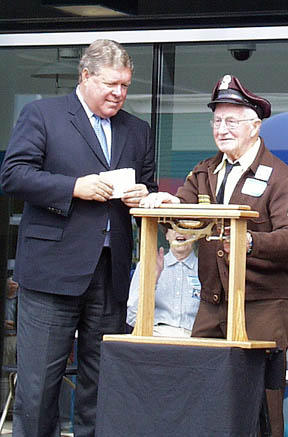President Bush was in Washington state on Friday, but the big story in Tacoma was the loud introduction of Sound Transits first segment of its Link light rail system.
The new transportation system marks the first streetcar to run in Tacoma since 1938.
We really are going back to the future, said Tacoma Mayor Bill Baarsma, just one of a number of political and business leaders on hand for the long-awaited debut of Tacoma Link.
They joined a crowd of about 1,000 people who turned out between 25th Street East and Tacoma Dome Station to take part in the daylong festivities and enjoy the party atmosphere.
Those in attendance at the opening ceremony enjoyed music courtesy of the Fabulous Roadsters and refreshments from Taste of Freighthouse Square and the Freighthouse Square Food Court. Commemorative posters were signed by artist Virginia Bunker. Blue and white balloons – the colors of Sound Transit – dotted the area, with more than a few escaping into the sky from the tenuous grasp of youngsters.
For their part, politicians focused on the positive, seeking to blunt criticism from some that the $80.4 million, 1.6-mile project is a fiscal boondoggle that goes nowhere.
The system were starting today is a shining example of what we can accomplish when we stop bickering and start building, said Sound Transit Board Chair and King County Executive Ron Sims. Its a loud and clear notice that Sound Transit can and does deliver.
This is a taste of what well be doing when we build Central Link 40 miles to the north, added Sims, a Democratic candidate for governor, a reference to the agencys planned $2.4 billion, 14-mile Seattle-area light rail project.
Tacoma Link is an important piece of Sound Transits regional network, and Pierce County is proud to have the regions first modern light rail system, said Sound Transit Board Vice Chair and Pierce County Executive John Ladenburg. You can ride the train from downtown Tacoma Dome Station and literally go anywhere in the world.
Ladenburg pointed to Tacoma Dome Station as the regions first truly multi-modal transportation hub. The facility provides connections to a host of other transportation options, including ST Express regional bus serve, Pierce Transit local bus service, Sound Transits Sounder commuter rail, Greyhound buses, nearby Amtrak intercity rail service and now Link light rail.
Kevin Phelps, a Sound Transit Board member and Tacoma City Councilman, called multi-modal transportation the key to Tacomas economic development, describing Link as the anchor of $1 billion worth of investment in downtown.
Tacoma Link will play a proud and prominent role in downtown Tacomas ongoing renaissance, he said. It will attract people and more positive development downtown by providing a fast, modern way for people to hop between our thriving businesses, museums, theaters, education institutions and destinations both here and far. New businesses and developments are already coming online and existing businesses will flourish as downtown workers, students and tourists leave their cars to ride the train.
Politicians also stressed what the new light rail system means to the future of Tacoma, the Puget Sound region and Washington state.
Baarsma said he hoped this would be the first step in creating an electric car line between Tacoma and Seattle that disappeared 73 years ago.
Its a great day for the people of Washington, he said, noting Tacoma has come full circle since being selected in 1873 as the western terminus of the Northern Pacific Railroad. This light rail line is the ribbon that ties everything together.
Ladenburg announced the Puyallup Indian Tribe will spend up to $50,000 to study a possible extension of the streetcar line to the tribes planned casino complex off of Interstate 5. Such an extension would reach Portland Avenue, he said.
We are already studying the expansion of this light rail line, Ladenburg told the crowd, noting the lines possible expansion to such places as Olympia, Auburn and Federal Way. The bottom line is we need to get it built.
There is no more important issue in the region than transportation, said U.S. Rep Norm Dicks (D-6th District). So there is a real hunger for additional transportation.
After the conclusion of the mornings many speeches, it was time for the launch the first streetcar service in Tacoma in over 65 years.
Eighty-six-year-old Cliff Fournier of Tenino, the last living trolley operator from the Tacoma Railway and Power Co., then took center stage, along with Dicks and Sims, to ring a bell officially launching Link light rail.
A spry Fournier said he planned to live to 100 in order to come back to Tacoma to see the expanded Link.
After the ringing of the bell and amid a shower of blue and white confetti and ear-splitting fireworks, a Tacoma Link streetcar pulled out of Tacoma Dome Station and prepared to pick up its first official passengers. Promotional ticket winners and – of course – politicians were the first to board the streetcars, as a horde of people swarmed the car to get a better look and take pictures.
Fournier, dressed in his motormans uniform, joined politicians and others inside the Link vehicle, tipping his hat and posing for photographs.
Streetcars were then opened to the public, and a long line quickly formed.
Tacoma Link runs seven days a week between Tacoma Dome Station at Freighthouse Square and the citys historic Theater District. It provides free service between 6 a.m. to 8 p.m. Monday through Friday, 8 a.m. to 10 p.m. on Saturday and 10 a.m. to 8 p.m. on Sunday.
In 1996 voters approved funding for Sound Transit to provide a regional system of transit improvements, including Link light rail.







